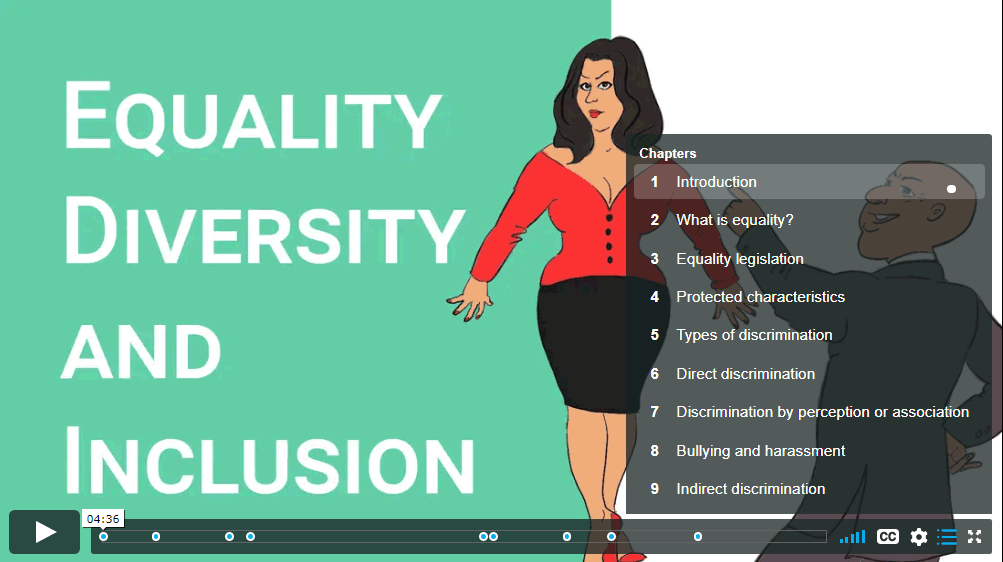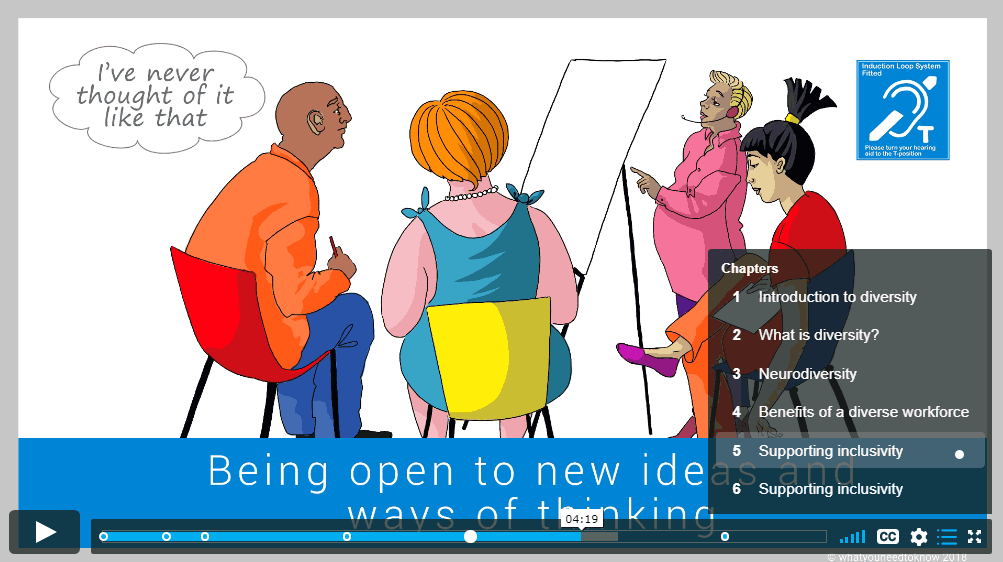There are two videos to watch. The first is an introduction to equality, diversity and inclusion and explains the protected characteristics. These are important as it’s illegal to discriminate against a person because of a protected characteristic. They are also important when looking at bullying and harassment. Essentially harassment involves one or more of the protected characteristics.
The second video takes a much closer look at diversity and ‘all the ways we’re different’. It then looks at how some organisations are making their environments more inclusive.
Introduction
What is equality?
Equality legislation
The protected characteristics
Types of discrimination
Direct discrimination
Discrimination by perception or association
Indirect discrimination
Bullying and harassment
You can use the ‘chapters’ from the play bar to skip to these sections.

What is diversity?
Neurodiversity
Benefits of a diverse workforce
Supporting inclusivity
Changes in what’s acceptable
You can use the ‘chapters’ from the play bar to skip to these sections.

Equality Diversity and Inclusion
Throughout history people have been persecuted because they are different. The difference might have been their race, faith, sexual orientation, or something else. Persecution is a strong word, but people are being discriminated against today for the very same reasons.
Let’s start with equality.
Equality is about making sure people aren’t disadvantaged, discriminated against or excluded from full and fair participation.
Although we often think of discrimination in terms of employment, it also concerns how we are treated when we are customers, and the way we treat others.
But treating everyone equally doesn’t necessarily mean treating everyone in exactly the same way, some people might need more help to get the same chances.
The legislation which protects and supports us in this area is the 2010 Equality Act (UK law). A key part of this Act is what’s known as the protected characteristics. There are nine in total, we’ll have a look at each of them and then see some of the different ways people discriminate against others.
Age is a protected characteristic. Perhaps a job applicant wasn’t accepted as they were thought to be ‘too old’ or ‘a bit past it’ – or they ‘didn’t have enough experience’. An example of discrimination would be an employer stating the applicant must have ten years’ experience, so as to discriminate against younger people.
A disability could be to do with the senses, like a visual or hearing impairment, or a physical disability perhaps something that restricts a person’s movement, and there are also mental disabilities such as schizophrenia, anxiety or a disability caused by depression.
Race includes colour, nationality, citizenship and ethnic or national origins.
There are lots of cases where people have been discriminated against because of their religious or philosophical beliefs, but it’s also illegal to discriminate against someone because they have no religious or philosophical beliefs.
A person’s sex, or gender, and also gender reassignment – both during and after the reassignment process are protected as is a person’s sexual orientation and marital status –whether they’re married, divorced, in a civil partnership or single. And finally, pregnancy and maternity so for example, a woman can’t be asked to leave a restaurant because she’s breast feeding a child.
Let’s have a look at three different types of discrimination.
Perhaps the most obvious is when people are directly discriminated against.
This is Jake. He’s got plenty of experience of working in restaurants and felt he had a good chance when he saw that waiting staff were needed – so he applied for the job. The manageress wanted to employ a woman because she felt women attracted more customers. This is an example of direct discrimination. Jake was discriminated against because he’s man. His sex, or gender.
Let’s say the manageress was happy to employ male waiting staff, but she didn’t employ Jake because she thought that, as he was friends with a lot of gay people, he might also be gay. In this case, he would have been discriminated against by perception or association of the protected characteristic – sexual orientation.
This restaurant has a dress code which says that staff in customer facing roles mustn’t use headwear. It’s the same rule for everyone, but what this means is that staff who use headwear as part of their culture or faith are being discriminated against. And this is an example of indirect discrimination. The owners would have to have an objective reason to justify this policy for it not to be discriminating against those members of staff.
So people can be discriminated against for all sorts of reasons and in lots of different ways. But differences are also used to tease, mock, harass or bully. People who do this will often say things like they were ‘only having a laugh’, or ‘it’s just a bit of fun’, ‘it doesn’t mean anything’. The victims use words like degrading, humiliating, intimidating.
If someone feels threatened, upset or disturbed by a particular behaviour, then that’s harassment, whether it’s intentional or not.
As individuals we have different values, attitudes, beliefs and abilities – we come from different backgrounds and form a diverse culture. Understanding the legislation is part of ensuring that everyone is included and can fully participate, and making sure we’re all on a level playing field and treated fairly and equally.
Diversity and Inclusion
When diversity’s portrayed, it’s often shown as a mixture of people of different ages, abilities, gender, or with other visible differences.
But look at this. Sam and Chloe have been friends for years. They lived in the same street, went to the same school, liked the same boy bands, and have a lot in common. But they were born in different countries.
Geraldine, went to the same private school as her mother, and then onto one of the most prestigious universities.
There are some things that all three have in common, and other areas where they’re all very different.
The point is, when we talk about diversity, we’re talking about all of us, and all the ways we’re different. It can include things like the type of education we had, where we were born and grew up, our family background. Our physical and mental abilities, and also our values, attitudes and beliefs. Some of these are visible, but many of them aren’t. Here’s an example.
Pete’s great at problem solving, analytical thinking and staying focussed on tasks. He can assimilate and retain lots of detailed information. He’s a punctual, reliable, and dedicated employee.
But Pete finds it hard to ‘read’ people which makes some situations difficult for him. Some see him as being aloof and unfriendly, but that’s not fair or true. He’d like to be more involved, but he often feels anxious and unsure of himself.
Pete’s difference is sometimes described as a thinking style, or being neurodivergent, and in the past, this was often seen as an impairment, but now people are beginning to see beyond the differences to the person behind them. And a good example of this is from the television show, ‘Britain’s Got Talent’.
Susan Boyle was one of the contestants, she looked a little awkward during the introduction section, and stumbled on some of the questions. There were some knowing looks from the judges, and everyone was expecting a really awkward performance. But when she sang, she sang beautifully. After her performance, Amanda Holden, who was one of the judges, said, “I’m so thrilled, because I know that everybody was against you. I honestly think we were all being very cynical, and I think that was the biggest wake up call ever.”
Many organisations now value the benefits that a diverse workforce can bring – and here are some of the reasons they give.
We need a balanced team with a mixture of skills, experiences and ways of looking at things.
We’re all different so we don’t define someone by their differences – instead we value people for what they have to offer.
Diversity helps us drive productivity and profits, and gives us a competitive advantage.
We have fair and equal selection and promotion practices. This means we have a larger pool of candidates to select and promote from. And this leads to diversity throughout the whole organisation.
Our customers come from all walks of life – and so do our staff. That means as an organisation we have a better understanding of our customers and are more representative of them.
In order for a diverse group of people to work together successfully, the work environment needs to be one where everyone is able to contribute to their full potential, and where no one is defined by, or held back – because of their differences.
Here are some of the things that organisations are doing to help support inclusivity.
One is removing barriers that restrict disabled people. For example, someone with a visual impairment may not be able to use a mouse or other pointing device with a computer.
Instead they use the tab key to navigate and a screen reader to read out the text. For this to work, documents must be formatted with headings, subheadings and so on. Formatting documents in this way is actually good practice, and it helps everyone who uses the document, including any customers.
Another example is making sure passageways are wide enough, and kept clear, so that people with physical disabilities can move around a building more easily. And also installing equipment such as induction loops for people who use hearing aids, or have cochlear implants.
When there are diverse attitudes and ways of looking at things, there’s a chance that previously held assumptions will be challenged. Many organisations are supporting and encouraging a culture of openness so that new ideas and perspectives can be discussed freely.
Flexible working hours, working from home, or job sharing, can make the difference between someone, especially someone with other commitments, being able to continue working or having to give up their job. A flexible working environment may also make it easier for someone to return to work after a break.
Some social activities might exclude people, and therefore not be inclusive as a work-related activity.
For instance, a team get together over a drink is unlikely to be suitable for a recovering alcoholic, someone who has to drive, or possibly someone on medication. And there are more inclusive alternatives.
Of course, they’re not saying a group of friends from work can’t go out for a drink. This is about making sure people aren’t excluded from work-related activities because of their personal situation.
Language and images can be offensive. A shared environment with colleagues and perhaps customers and visitors, isn’t the same as a private space, so again being inclusive is about being respectful of other people’s values and sensibilities.
You’re probably familiar with some, or all, of these ideas, and over the years many of them have been met with mixed reactions. But there are lots of examples of behaviours that were seen as normal, or were tolerated in the past, which are no longer acceptable, and especially not in the workplace.
Not so many years ago, smoking in public buildings and offices was commonplace, but not anymore. And even though legislation was used to enforce this, it’s hard to imagine many people wanting to return to those days.
There’s a saying that when technology works, it’s invisible. We flip a switch and the light comes on. We turn on a tap and water comes out. And we only notice technology when something goes wrong.
And inclusion’s a bit like that.
When people aren’t included it’s noticed, people are left out, or not able to participate. But when inclusion is a part of a culture, we tend not to notice it, as our differences are either irrelevant or help to make us stronger.
